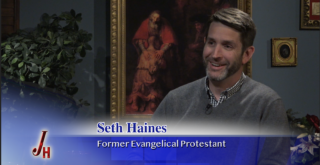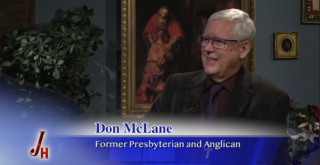Whether one is Catholic or non-Catholic, we can’t miss the news of reported apparitions of Mary occurring all around the globe, often to young children from third world countries. How should we take these reports? Should we merely write them off as hysterical fanaticism or figments or overzealous imagination? Are they staged counterfeits by people seeking fame? Are they of the devil and his demons? Or is Mary truly appearing and speaking to Her children? The following article explains how the Catholic Church evaluates and authenticates reported private revelation.
What norms or criteria does the Catholic Church use in evaluating a reported private revelation? The general criteria used by the Church in evaluating a reported Marian apparition can be divided into these three categories: 1) the revealed message content; 2) the nature of ecstasy and other concurring phenomena; and 3) the spiritual fruits. 1
Any reported message revealed in a private revelation must be examined in light of the public revelation contained in Scripture and Tradition as safeguarded by the Church. If any reported message conveys a substantial doctrinal or moral error against Church teaching, the reported revelations are deemed to be false. The Holy Spirit, the same divine source of inspiration for public revelation and authentic private revelation alike, cannot contradict Himself. Since private revelation is at the service of public revelation, then the “command to act” given by private revelation must correspond to the “revealed doctrine” of public revelation.
Secondly, the nature of ecstasy experienced by the “visionary” or recipient of prophecy or apparition is another principal factor in the process of Church investigation. Oftentimes, the visionary or recipient of a major private revelation is partially removed from an ordinary time and space experience during the God-granted revelation, and is partially brought into the temporal-spatial experience of the giver of the revelation, whether it be Jesus or Mary. In other words, the visionary is brought into an ecstatic state that at least partially transcends his usual sense experience.
A medieval means of testing the authenticity of a reported visionary during ecstasy included the injecting of a large needle into the arm of the alleged visionary to test the legitimacy of his or her ecstatic state. The much improved modern means of medico-scientific testing during a reported ecstasy (which includes EKG, EEG, and other technological data) has been a great help to the Church in distinguishing empirically a legitimate state of ecstasy from a false report. 2
Other phenomena related to private revelation and worthy of examination include reported physical signs, such as solar miracles (as at Fatima), or miraculous springs (as at Lourdes), which cannot be explained by natural means, but only by a direct intervention of God.
Thirdly, the spiritual fruits constitute a major criterion for the authenticity of a private revelation, based on the scriptural message in which Our Lord refers to the good tree bearing good fruit: “for the tree is known by its fruit” (Mt 12:33). One of the best indications for the authenticity of a reported private revelation is when the resulting devotion manifests true and ongoing conversion, as seen in a return to the prayer and sacramental life of the Church (i.e., Mass, Confession, Rosary, fraternal charity, etc.).
Although it is possible for some spiritual fruits to result temporarily from a false private revelation because of its partial conveyance of the truths of Christianity; nonetheless, a revelation of either human or satanic origin cannot manifest substantial and consistent spiritual fruits comparable to the qualitative and quantitative spiritual benefits of a true revelation which has God as its ultimate source. The work of God and the work of man or Satan can never be seen as having identical fruits.
It is also noteworthy that even in the case of an authentic private revelation, it often happens that some error in the receiving or the transmitting of the revelation may occur because of the ever present human nature of the visionary. Several authentic private revelations that have received official Church approval have also had some secondary elements of human error, even when the visionary has been a canonized saint.3
If, after proper examination (usually performed by the local bishop), the Church is satisfied with the indications of authenticity and has excluded probabilities of error or fraud, she can grant its official approval. Normally, official Church approval means that there is nothing against faith and morals in the revelation and concurring phenomena, and that the faithful are free to accept the private revelation without concern for doctrinal or moral error. This is sometimes called a “negative approval,” meaning the Church does not guarantee its authenticity, but officially pronounces the revelation free from doctrinal or moral error and thereby worthy of belief. This doctrinal clearance allows the faithful greater freedom regarding the acceptance of the revelation.
Degrees of Church Approval
Historically, the Church has exercised different degrees of official approval in regard to Marian private revelations. For example, to the Marian apparitions at Knock, Ireland (1879), the Church gave what may be called an “approval by omission.” By withholding official judgement and examining the devotion that came as a result of the reported apparitions, the Church has indirectly approved Knock as authentic by the acknowledgements of “Our Lady of Knock” and by visits to the apparition from Church authorities (for example, by Pope John Paul II).
Other reported Marian apparitions have received a degree of Church approval that goes beyond the usual negative approval, i.e., that it is not contrary to faith and morals. A few apparitions have actually received a positive judgement concerning their authenticity from the local bishop. This has happened, for example, in the Marian apparitions at Beauraing, Belgium in 1932-33, and in Bethania, Venezuela in 1987.
Any degree of official Church approval does not oblige the faithful to accept a Marian revelation, since it never directly affects the public revelation contained in the deposit of faith. Authentic private revelation, therefore, is normally given the assent of “human faith” based on prudential discernment, but not “divine faith” appropriate for public revelation.
As Pope Benedict XIV stated:
Even though many of these revelations have been approved, we cannot and ought not give them the assent of divine faith, but only that of human faith, according to the dictates of prudence whenever these dictates enable us to decide that they are probable and worthy of pious credence.4
On the other hand, the fact that the Church has given her approval after careful and oftentimes scrutinous examination offers strong evidence for the prudence of human acceptance of a particular revelation. This is specifically the case regarding private revelations that the Church has “made her own” through papal statements, visits, and even liturgical celebrations, such as has happened with the revelations of the Sacred Heart of Jesus to St. Margaret Alacoque or the Marian apparitions of Lourdes and Fatima.
Moreover, it would be reprehensible if any Catholic, after the Church had granted her negative approval of a private revelation, were to contradict or ridicule a Church-approved private revelation or its corresponding devotion. Although the general faithful are called to give only an assent of human faith, it is also theologically held that the visionary and any others intimately connected with the revelation may and should accept the revelation with the assent of divine faith.5
1 For discussion of Church criteria, cf. R. Laurentin, “Role of Apparitions in the Life of the Church,” presentation at National Conference on Medjugorje, Notre Dame University, May 12, 1989.
2 For example, cf. R. Laurentin and H. Joyeux, Scientific and Medical Studies in the Apparitions at Medjugorje, (Dublin: Veritas Press, 1987).
3 Cf. Augustin Paulan, Graces of Interior Prayer, St. Louis, 1950.
4 Pope Benedict XIV, De servorum Dei beatificatione et beatorum canonizatione, v. 1-7 of Opera Omnia, 17 v. in 20; 2:32; 3:53.
5 Cf. Jordan Aumann, O.P. Spiritual Theology, (London: Sheed and Ward) p. 429.










